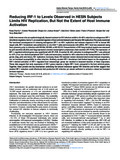Reducing IRF-1 to levels observed in HESN subjects limits HIV replication, but not the extent of Host immune activation.

View/
Date
2015-10Author
Su, RC
Plesniarski, A
Ao, Z
Kimani, J
Sivro, A
Jaoko, W
Plummer, FA
Yao, X
Ball, TB
Language
enMetadata
Show full item recordAbstract
Cells from women who are epidemiologically deemed resistant to HIV infection exhibit a 40–60% reduction in endogenous IRF-1
(interferon regulatory factor-1), an essential regulator of host antiviral immunity and the early HIV replication. This study examined
the functional consequences of reducing endogenous IRF-1 on HIV-1 replication and immune response to HIV in natural HIV
target cells. IRF-1 knockdown was achieved in
ex vivo
CD4
+
T cells and monocytes with siRNA. IRF-1 level was assessed using
flow cytometry, prior to infection with HIV-Bal, HIV-IIIB, or HIV-VSV-G. Transactivation of HIV long terminal repeats was assessed
by p24 secretion (ELISA) and Gag expression (reverse transcription–polymerase chain reaction (RT–PCR)). The expression of
IRF-1–regulated antiviral genes was quantitated with RT–PCR. A modest 20–40% reduction in endogenous IRF-1 was achieved
in >87% of
ex vivo–
derived peripheral CD4
+
T cells and monocytes, resulted in >90% reduction in the transactivation of the HIV-1
genes
(Gag, p24) and, hence, HIV replication. Curiously, these HIV-resistant women demonstrated normal immune responses,
nor an increased susceptibility to other infection. Similarly, modest IRF-1 knockdown had limited impact on the magnitude of
HIV-1–elicited activation of IRF-1–regulated host immunologic genes but resulted in lessened duration of these responses.
These data suggest that early expression of HIV-1 genes requires a higher IRF-1 level, compared to the host antiviral genes.
Together, these provide one key mechanism underlying the natural resistance against HIV infection and further suggest that
modest IRF-1 reduction could effectively limit productive HIV infection yet remain sufficient to activate a robust but transient
immune response
Citation
Mol Ther Nucleic Acids. 2015 Oct 27Publisher
University of Nairobi
Collections
- Faculty of Health Sciences (FHS) [10415]
